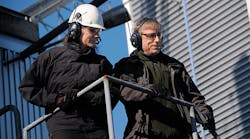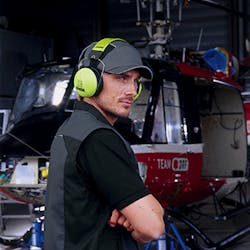Even a low level of noise can be hazardous to the human ear and noise exposure can have serious health consequences, ranging from hearing loss and tinnitus to hypertension, ischemic heart disease, annoyance and sleep disturbance. Earplugs and other devices can reduce and even eliminate noise exposure, and there are now apps to measure the noise level and obtain recommendations on appropriate hearing protection.
Let’s start with the good news: “When it comes to the damage a person can suffer from a noisy workplace, there has been an increasing awareness recently,” says Manfred Schuster, head of hearing protection at Uvex.
Joao Rosario, an application engineer in the Personal Safety Division of the multi-technology group 3M, said he believes that this is important because “although medicine has made amazing progress in the treatment of hearing damage in recent years, it’s impossible to eliminate all hearing problems.”
Hearing loss can start at a relatively low noise level of 85 decibels. This is because noise is cumulative, so that even low-level noise can add up to a dangerous total. The pain threshold starts at around 120 decibels. If the noise level is very high, it can damage a person’s hearing within a very short time.
Noise-induced hearing loss occurs when the hair cells in a person’s hearing organ virtually are dissolved for lack of oxygen, caused by repeatedly excessive sound waves. This is because the hair cells react to pressure fluctuations of the membranes, which they then pass on to the brain as electrical stimuli. Hair cells that have been destroyed cannot be replaced or newly formed.
Preventative action to reduce noise exposure continues to be vital to the prevention of hearing loss, and so does the use of personal protective equipment (PPE). Protection of the workforce is gaining in significance, partly due to demographic changes to the workforce and partly to shortages of skilled employees.
Younger workers just entering the workforce tend to underestimate the hazards caused by noise. “This puts them especially at risk,” says Rosario, as they usually only react quickly if they experience acute hearing loss, caused by excessive noise. It often takes 10 to 20 years before people become aware of any long-term damage.
Yet a person’s hearing is not the only thing that is affected by noise. Noise can cause stress to the entire body, causing poor concentration, gastrointestinal disorders and high blood pressure. It can even increase the risk of a heart attack
One issue, in particular, is currently attracting attention: the new European PPE Regulation 2016/425. This new legislation, which has been in effect since April 2016, puts hazardous noise in Category III, i.e. “risks that may cause very serious consequences such as death or irreversible damage to health.”
Now, manufacturers must have their ear protection products checked for conformity on an annual basis; until recently, it was sufficient to have a renewed inspection five years after receiving an EU-type examination certificate. The purpose of this new law is to increase safety for end users.
“Nothing much has changed for us,” says Manfred Schuster from Uvex. “We obtain our plastics from A-suppliers whom we see as strategic partners. They, too, have to submit to continuous checking by external bodies… Uvex believes that it is part of [our] everyday business to exceed the expected standards. Incoming goods are therefore spot-checked on a regular basis.”
The downside of the new regulation is that procurement has become more expensive. The new regulation even specifies instructions for use and care. Similar to a patient leaflet for a pharmaceutical product, these instructions now need to be provided in a specified paper size, with comprehensive details in a particular font size and must be provided in 27 languages. Even the smallest packages of hearing protection must include the directions to ensure that hearing protection is correctly used and maintained.
Different Noisy Environments
One major challenge is the variety of noise levels in the working environment. “As working conditions change,” says Rosario, “it becomes more and more important to use hearing protection which is suitable for a variety of noisy environments.”
The 3M technology group has developed earplugs where users can toggle between a higher and lower level of protection, while also being protected against impulse noise – i.e. short, sudden bursts of noise.
Although efforts continue to reduce machine noise, some industrial worksites and work tasks remain noisy, such as demolition and construction projects and any work that involves metalworking and woodworking equipment. But even the “pleasant noise” of a band or orchestra can have a detrimental effect on the listener’s health.
Probably the most reasonably priced way for protection is to use a pair of simple foam earplugs. Although this form of PPE protects the wearer against the damaging effects of noise, created by air pressure in the ear, the noise still is perceived by the user and communication can be difficult.
One alternative to ready-to-use earplugs is ear molds that can be individually adjusted. With this form of hearing protection the emphasis is on both speech intelligibility and comfort. This kind of specially customized hearing protection now can be manufactured in a 3D printing process at a millimeter accuracy. Nevertheless, the devices still need to be checked – both at delivery and then at regular intervals – to make sure they maintain their protective function.
Preventative action to reduce noise exposure continues to be vital to the prevention of hearing loss, and so does the use of personal protective equipment.
Another hearing protection product that currently is gaining in popularity is one that can be used in conjunction with a smartphone, when listening to music or making phone calls. For certain professional groups, such as wind turbine mechanics and forestry workers, it is important to stay in touch with colleagues across distances. This can be ensured through active hearing protection.
Another area which is receiving more and more attention is earplugs, earmuffs and hearing aids with miniature batteries. They can deliver level-dependent attenuation while also amplifying very low noises – a useful feature for military purposes.
The more complex and expensive the hearing protection, the more there is a demand for accessories. “Hygiene sets, for instance, play a major role – both in passive and active earmuffs,” says Rosario. “Active hearing protection involves accessories such as wind protection for microphones, rechargeable batteries and rechargers.”
Accessories now offer increasingly smart solutions. “Electronic hearing protection,” says Manfred Schuster, “can now be provided with packaging that has integrated rechargers.”
Hearing Protection Is More than PPE
Training is another important factor in hearing protection. Once the right kind of protection is identified, employees should be given training and information on the appropriate use of equipment. Uvex puts up small stands in its customer company’s cafeterias to provide information. In addition to obtaining advice and training on their own premises, some PPE companies, such as Uvex and 3M, offer safety engineers train-the-trainer type courses so they can share best practices with employees at their facilities.
PPE companies also are expanding into smart phone apps. Both Uvex and 3M have a decibel app which users can use on their smartphones to decide whether they ought to wear hearing protection. Appropriate noise protection options are then presented in the form of a color scale. Green means that no protection is needed, yellow that it is mandatory and red that protection must be specially adjusted to suit high- or medium-frequency noise. Then the app then recommends suitable products. Such apps also are an way to sharpen one’s sensitivity to noise and to assess the potential hazards correctly.
About the author: Kirsten Rein is a freelance journalist in Frankfurt, Germany.


